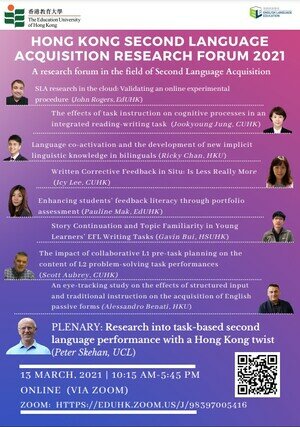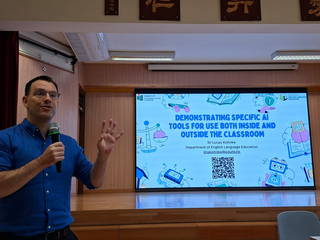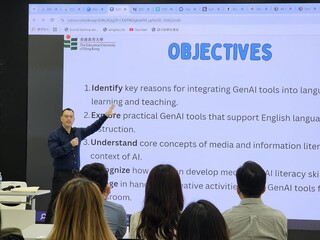Hong Kong Second Language Acquisition Research Forum 2021
- 13 Mar, 2021 | 10:15 am - 5:45 pm
- Online via ZOOM
- Forum
- English
- Department of English Language Education
Hong Kong Second Language Acquisition Research Forum (HK-SLARF) represents a group of academics working in Hong Kong who share an interest in second language acquisition (SLA). This colloquium is a forum in which we present papers on our latest research and discuss developments in the field of SLA.
Hong Kong Second Language Acquisition Research Forum 2021
This study, which is part of an ongoing research project (Rogers, Nakata, & Chiu, in progress), examines how retention of Swahili-English word pairs is affected as time between training sessions (intersession interval, or ISI) is increased from 5 minutes to 14 days, as measured on a 10-day delayed posttest in a three-session study. I report here on the initial efforts to validate our online experimental procedure by benchmarking data collected online against data collected in a laboratory setting (Cepeda et al., 2009).
The experimental design of this study is an online replication of Cepeda et al. (2009), which was conducted in a face-to-face laboratory setting. Participants (N=250) were recruited via Prolific, an online recruitment service, and were randomly assigned to one of six conditions (0-,1-,2-,4-,7-,14-day gap) where they were trained on 40 Swahili-English word pairs over two training sessions. Following the second training session, participants were subsequently tested using a battery of measures on a 10-day delayed posttest. The entire study was carried out using Gorilla, an online experimental platform.
The usable data from the posttest of this study will be benchmarked against the data from Cepeda et al. (2009). In addition, the results will be discussed in terms of data quality, with a focus on exclusion rates due to low effort on the part of individual participants, failed bot check / attention check questions, as well as general participant attrition over the course of the study. Finally, the results will be discussed more broadly in terms of methodological considerations for SLA researchers carrying out longitudinal experimental studies in online environments.
To date, little attention has been paid to the applicability of task-based language teaching (TBLT) into tasks that entail multiple language skills. To fill this gap, the present study explored how task instruction affects L2 learners’ cognitive processes while performing an integrated reading-writing task, as reflected in their eye-movements, keystroke logs, and stimulated recalls.
Seventy-two Korean undergraduate students read an English essay following one of two different instructions. In one condition, participants were instructed to read the essay in order to prepare for an upcoming debate; in the other, participants were asked to read the essay promptly, as the library was about to close. After reading, participants produced an unannounced summary of the essay. To analyse participants’ on-line processes, their eye-movements were collected with an eye-tracker, and keystroke-logs were recorded using Inputlog. Upon the task completion, ten students from each condition further produced stimulated recall comments.
The triangulated data revealed that expecting a debate led participants to make more pauses during reading to process word meanings, read more slowly and repeatedly to maintain their concentration and comprehension level, and notice more lexical items from the essay (for R scripts, McCray, 2016). By contrast, when reading expeditiously, participants tended to skim the essay, often skipping supposedly unimportant parts. It was also found that participants who read for a debate were significantly more likely to pause during writing to plan and review both language and content, delete unsure or unsatisfactory wording, and insert additional information or expressions. Average pausing duration and writing fluency, however, were unaffected by task instruction.
The findings of this study manifest the substantial impact of task instruction on the way L2 learners process input and in turn produce input-based output. Theoretical, methodological, and pedagogical implications of this study will be discussed in the framework of TBLT.
Abundant psycholinguistic studies have demonstrated that when bilinguals perform a task in one language, they cannot avoid activating relevant representations in their non-current language(s), leading to cross-linguistic facilitation or interference effects. However, these studies focused on moment to moment ‘cross-talk’ effects stemming from bilinguals’ existing linguistic knowledge. In this talk, I will present two experiments which sought to determine how the activation of the non-current language(s) contributes to the construction of new implicit linguistic knowledge, which is believed to underlie true competence in real-time language processing and production.
In Experiment 1, Cantonese-English bilinguals and native English participants were tested on their incidental learning of novel mappings between artificial articles (gi, ro, ul, ne) and fire/water semantic categories (e.g., gi and ul went to fire-related words as in ‘gi bomb’, which was unbeknownst to participants). Methodological details will be presented in the talk. These two groups of participants were recruited because of the difference in how written Chinese and written English encode semantic categories. Specifically, semantic categories are encoded explicitly in phono-semantic compounds most commonly found in written Chinese. For example, the semantic radical 氵in 河 (river) denotes ‘water’, whereas 火 in 炸彈 (bomb) denotes ‘fire’. On the other hand, fire/water semantic categories are rarely explicitly encoded in written English (e.g. mainly in compound nouns such as waterfall and fireball). While the entire experiment was conducted in English, we hypothesized that only the Cantonese-English bilinguals would show learning effects of the target form-meaning connections due to facilitative effect from the activation of their non-current Cantonese. However, mixed-effects regression analysis reveals that both groups developed implicit knowledge of the target form-meaning connections, and the results provide no conclusive evidence for our initial hypothesis.
In Experiment 2, another group of Cantonese-English bilinguals completed the same experimental procedure except that they watched a 30-minute English video beforehand which served to suppress the activation level of their L1 Cantonese. The learning effects in the bilingual group could no longer be found. Results from both experiments demonstrate that the covert activation of their non-current L1 Cantonese could facilitate the development of new implicit linguistic knowledge of the target form-meaning connections. The findings not only extend current research on semantic implicit learning and its constraints, but also suggest that the constant activation of non-current language(s) in bi/multilinguals may be the cognitive basis of long-term L1/cross-linguistic transfer effects in second language acquisition. Pedagogical implications will also be discussed.
In different parts of the world, L2 teachers devote a huge amount of time to giving feedback on student written errors. Such written corrective feedback (WCF), which is unfocused and comprehensive, is fraught with problems for both teachers and students. Nonetheless, it remains a prevalent practice in many L2 contexts, especially EFL contexts. Although research on focused WCF has provided evidence about its benefits, the bulk of it has been conducted in experimental classrooms with limited pedagogical relevance to authentic classrooms. In recent years, there has been a call to conduct WCF research in situ (Atkinson & Tardy, 2018). To this end, this study investigates two secondary teachers’ implementation of focused WCF in the Hong Kong EFL writing context. Data were gathered for one academic year from interviews with teachers and students, classroom observations, students’ writing, as well as pre-and post-writing tests. The findings suggest that focused WCF is feasible in authentic classrooms when it is aligned with writing instruction and provided on pre-selected error types and selective errors based on individual students’ needs, providing an impetus for teachers to strengthen their writing pedagogy and freeing them up to enhance feedback on other areas of student writing. The study points to the possible positive impact of focused WCF on the accuracy of both target and non-target errors, as well as students’ engagement with revision, and concludes with implications for the pedagogy of focused WCF in similar contexts.
Feedback lies at the heart of teaching and learning and is a catalyst to the development of student learning. Central to the efficacy of feedback is “student feedback literacy,” defined as students’ understanding, capacity and the dispositions needed to make sense of feedback information and use it to enhance their learning. In second language writing contexts, such as China and Hong Kong, one-shot writing, which compresses the writing process into a single draft, is prevalent. Moreover, the conventional feedback practice, which features one-way teacher-directed transmission, appears to be the main approach. Self and peer assessment, where learners take control of their learning and assessment, are not commonly carried out. The present practices thus limit opportunities for students to develop their evaluative capacities to use feedback productively, which hinders the development of student feedback literacy. Against this backdrop, there is a need for more research on how, and to what extent students develop their feedback literacy in their instructional contexts. Such information is of considerable significance as feedback loses its purpose if it does not fulfil its role in promoting student learning. Drawing on data gathered from individual interviews with the principal, English Department Head, teachers, and students, stimulated recall with students, classroom observations, writing portfolio documents, students’ writing portfolios and students’ drafts with feedback over the course of one academic year from one primary school in Hong Kong, the results of the study indicate that the students possess better understanding of feedback, have greater capacities to make productive use of feedback and hold a more positive attitude towards their active role in the feedback process. Results also indicate that there are various contextual factors that interact with the development of student feedback literacy. The presentation will end with implications for student feedback literacy development and its significance for practitioners, teacher educators and writing researchers.
Primary and secondary school teachers often report that teaching young learners to write in a second language is a slow and effortful process (Copland, Garton, & Burns, 2014). At the same time, students in this age range also express a lack of motivation to write (Lee, Yu, & Liu, 2018). Therefore, there is a need to explore EFL writing pedagogy suitable for young learners. This study investigates how story continuation under different topic familiarity conditions serves as a viable pedagogical means in secondary schools. Ninety-one Chinese students in four intact classes of comparable proficiency levels were assigned into four writing task conditions in a 2⨉2 factorial design. Group 1 (Fam) was provided with the beginning of the familiar story, the Little Red Riding Hood in Chinese, and was required to complete the whole story in English. Group 2 (UnFam) had the same procedure as Group 1 but the topic was the Pied Piper of Hamelin, an unfamiliar fair tale to the participants. Group 3 (Fam+Input) was provided with a complete story of Little Red Riding Hood in Chinese and the reading material was taken away during the writing session. Group 4 (Unfam+Input) wrote on the same topic of group 2, but they were allowed ten minutes to read the complete story in Chinese before starting to write. The results showed that topic familiar promoted writing fluency and idea generation as indicated in the length as well as the lexical diversity of the compositions, but it does not affect the writing quality or the lexical sophistication. In contrast, the story continuation groups produced longer compositions and better writing quality, but these young students’ lexical profiles (both lexical diversity and lexical sophistication) were not influenced by the two input conditions. Pedagogical implications for EFL writing among young learners are discussed.
Research on pre-task planning to date has mainly focused on task performance. However, the effects of planning for a second language (L2) performance are contingent on what learners actually do during planning time. One important factor that may determine the quality and usefulness of planning behavior is whether learners use their first language (L1) or L2. This presentation will report on an investigation into the relative benefits of collaborative planning in the L1 and L2 in terms of ideas generated and transferred to an oral problem-solving task. Seventy-two Japanese university EFL learners were randomly assigned to one of two planning conditions: L1P (L1 planning, Japanese) and L2P (L2 planning, English). Dyads in each group were given 10 minutes to plan the content of a problem-solving task in the respective languages before individually performing the timed 2.5-minute oral task. Data took the form of transcribed planning discussions and transcribed task performances. All data were coded for idea units and sorted into categories of problem–solution discourse structure (situation, problem, response, evaluation). A qualitative comparison of L1 and L2 planners’ generation of idea units during planning, transfer and performance was conducted to supplement the quantitative analysis. Findings indicate the L1P condition has significant advantages over the L2P condition in terms of idea conceptualization, but this advantage had a limited impact on subsequent L2 task performance. In addition to reporting these finding, the presentation will discuss pedagogical implications in terms of possibilities for productively incorporating L1 planning during task implementation in foreign language contexts where learners share a common L1.
In this paper the results of an eye-tracking study exploring the effects of structured input and traditional instruction on the acquisition of English passive forms will be presented and discussed. The two main questions of this study were: (1) what are the effects of structured input and traditional instruction on accuracy when measured by an eye-tracking picture selection task? (2) would possible differences in accuracy between structured input and traditional instruction be accompanied by changes in eye-movement patterns? Sixty-four participants were assigned to one of two instructional groups. Neither groups received explicit information. A pre and post training design was adopted and participants were assessed through a picture selection eye-tracking task to measure accuracy and eye-movement patterns while they were processing auditory sentences. Results of the eye-tracking task indicated that the structured input group achieved significantly higher accuracy scores compared with the group receiving traditional instruction. The main findings from the present study revealed that structured input training might cause a change in L2 learners’ eye-movement patterns.
The presentation will explore the implications of Levelt's model of first language speaking for the second language case, especially with performance on second language learning tasks. A major section of the presentation will cover research into performance on such tasks, and most of this will have Hong Kong connections. A first section will cover more familiar areas such as task conditions, especially planning, and task characteristic effects, such as task structure. This will be followed by more recent research which particularly emphasises newer methods of measuring second language task performance; reexamines planning; covers repetition studies; and explores speaking styles. There will be a brief interlude to describe the actual Levelt model of first language speaking, and then this model will be the organising framework to locate the entire range of research results which will have been presented. It will be argued that the Levelt model provides many insights to enable interpretation of the results. But it will also be suggested that the model needs some modification if it is to take account of some of these newer findings.







